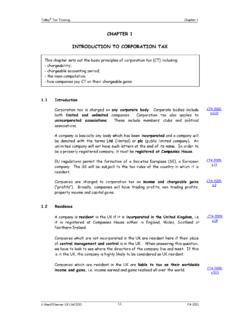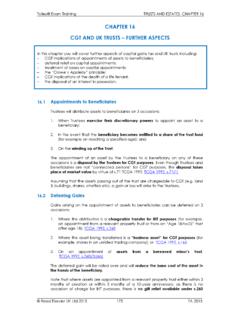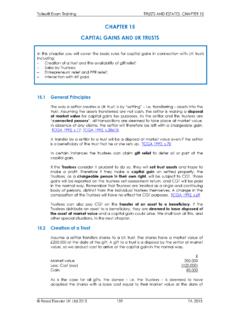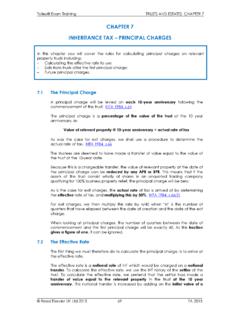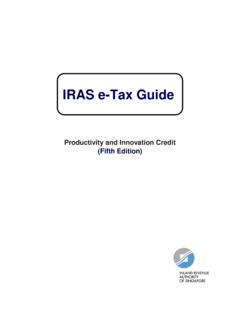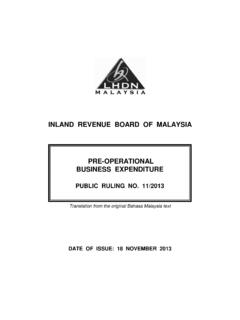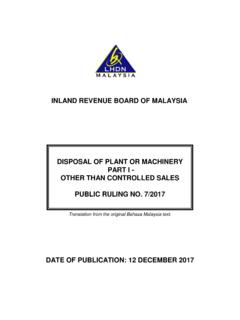Transcription of CHAPTER 10 CAPITAL ALLOWANCES – BASIC …
1 Tolley Exam Training BUSINESS TAX CHAPTER 10. CHAPTER 10. CAPITAL ALLOWANCES BASIC COMPUTATIONS. In this CHAPTER you will look at BASIC CAPITAL allowance computations including: computations in the general pool;. additions and disposals;. short and long accounting periods;. when expenditure is treated as being incurred;. pre trading expenditure ;. hire purchase agreements and leasing;. claiming and disclaiming CAPITAL ALLOWANCES . For the purposes of the illustrations and examples in this CHAPTER we will ignore both First Year ALLOWANCES and the Annual Investment allowance . These will be covered in the next CHAPTER . Calculating CAPITAL ALLOWANCES the General Pool . CAPITAL allowance (CA) computations are prepared for accounting periods; eg for the year ended 31 December 2015. CAs are a trading expense for a business and should be deducted in arriving at the trading profit figure for the accounting period. CAA 2001, Year ended 31 December 2015.
2 Adjusted profits before CAs X. Less: CAs (X). Trading profit X. The trading profit (ie after CAs) would then be taxed in 2015/16 under CYB. Individual CA computations are not necessary for every asset purchased. If so, this would be a horrendous exercise for large businesses who would be required to prepare a separate CA calculation for every piece of plant and machinery acquired. Instead, plant and machinery is usually pooled into a general pool (also known as the main pool ) and one computation is then prepared based on the qualifying expenditure within the pool. Plant and machinery ALLOWANCES are a fixed percentage of the value of the pool, calculated on a reducing balance basis. The rate of CAs in the general pool is currently 18%. Having claimed CAs within the pool at the fixed rate, the residual balance in the pool ( the tax written down value ) is then carried forward as an opening balance in the next accounting period where it will be written down again.
3 Reed Elsevier UK Ltd 2015 103 FA 2015. Tolley Exam Training BUSINESS TAX CHAPTER 10. Illustration 1. Barney is a self-employed courier. He started trading on 1 April 2013 when he bought a new van for 18,750. This is the only plant and machinery used in his trade. He draws accounts annually to 31 March. Compute the CAPITAL ALLOWANCES available for the first three years of trade. General CA claim Pool . Year ended 31 March 2014: Plant & machinery additions 18,750. WDA @ 18% (3,375) 3,375. Tax written down value c/fwd at 15,375. Year ended 31 March 2015: Tax written down value b/fwd 15,375. WDA @ 18% (2,768) 2,768. Tax written down value c/fwd at 12,607. Year ended 31 March 2016: Tax written down value b/fwd 12,607. WDA @ 18% (2,269) 2,269. Tax written down value c/fwd at 10,338. Barney will claim the CAs via his self-assessment returns and the amounts claimed will be deducted from his adjusted trading profits. General Pool Additions and Disposals When a trader buys additional plant and machinery for use in his trade, this addition must be brought into the CA computation.
4 Additions are brought in at cost. Where the cost of an asset includes VAT: 1. If the trader is VAT registered, the VAT will be recoverable from HMRC. The addition should then be the VAT-exclusive amount. 2. If the trader is not VAT registered, he will not be able to recover the VAT from HMRC. The addition should then be the VAT-inclusive amount as the VAT will be a cost of acquiring the asset. VAT registered businesses will produce accounts on a VAT-exclusive basis, so you will rarely have to adjust for the VAT. VAT cannot be recovered by any trader on the cost of a car which has any private usage. Car additions should therefore be shown as the VAT inclusive amount. If the trader originally bought the plant and machinery for private purposes, and then subsequently uses the plant and machinery in their business, the value on which CAPITAL ALLOWANCES can be claimed is the market value of the plant and machinery when it starts to be used in the business rather than the original cost.
5 CAA 2001, Reed Elsevier UK Ltd 2015 104 FA 2015. Tolley Exam Training BUSINESS TAX CHAPTER 10. The market value is also used instead of cost where the plant and machinery is gifted to the trader. CAA 2001, When a trader disposes of plant and machinery, the disposal must be taken out of the CA computation. The disposal value is deducted from the general pool and writing down ALLOWANCES are calculated on the balance. The disposal value is usually sale proceeds received. However market value will be used as the disposal value instead of sales proceeds in each of the following situations: Where the plant and machinery is sold for less than market value to someone who cannot claim CAPITAL ALLOWANCES ;. Where the plant and machinery is given away; and Where the trader simply stops using the plant and machinery in their business. If the sale proceeds (or market value where relevant) is more than the original cost of the plant and machinery, the disposal value is normally limited to the original cost.
6 CAA 2001, General Pool . Tax written down value (WDV) brought forward X. Additions (at cost) X. Disposals (usually sale proceeds restricted to cost) (X). X. ALLOWANCES @ 18% (X). Tax written down value (WDV) carried forward X. Illustration 2. Daisy is a florist. She has traded for many years from a shop in Covent Garden. She draws accounts annually to 31 March. The tax written down value of the general pool at 1 April 2014 was 12,000. Her recent CAPITAL acquisitions / (disposals) are as follows: . New computer &printer 1,900. Sold old computer (original cost 800) (100). New front door for shop 2,000. New till 1,000. Additional shelving and racking in shop 5,000. Compute the CAPITAL ALLOWANCES available for the two years ended 31 March 2016. Reed Elsevier UK Ltd 2015 105 FA 2015. Tolley Exam Training BUSINESS TAX CHAPTER 10. General Pool CA claim . Year ended 31 March 2015: Tax written down value b/fwd at 12,000. Plant and machinery additions: New computer and printer 1,900.
7 13,900. Disposals: Old computer (100). 13,800. WDA @ 18% (2,484) 2,484. Tax written down value c/fwd at 11,316. Year ended 31 March 2016: Tax written down value b/fwd at 11,316. Plant & machinery additions: New till 1,000. Shelving and racking 5,000. 17,316. WDA @ 18% (3,117) 3,117. Tax written down value c/fwd at 14,199. Note: The new front door on the shop is treated as part of the building under List A, so no plant and machinery ALLOWANCES are given. General pool Short and Long Accounting Periods Sometimes a trader may draw up accounts which are not for a 12-month period. This will happen either: a. when the individual starts trading; or b. when the trader decides to change his accounts date. The rate of writing down allowance of 18% applies for a 12-month accounting period. Therefore where a trader has an accounting period which is not 12 months long, this rate must be scaled up or down as appropriate. Illustration 3.
8 Jenny started trading on 1 June 2015. Her first set of accounts covered the period to 31 December 2015. Her only plant and machinery addition in the period was computer equipment costing 3,600. Compute the CAPITAL ALLOWANCES available in the period to 31 December 2015. Reed Elsevier UK Ltd 2015 106 FA 2015. Tolley Exam Training BUSINESS TAX CHAPTER 10. General Pool CA claim . 7 months ended 31 December 2015: Plant & machinery additions: Computer equipment 3,600. WDA @ 18% 7/12 (378) 378. Tax written down value c/fwd at 3,222. Illustration 4. Sanjay has traded for many years drawing accounts to 30 June. He decided to change his accounts date to 31 December and did so by drawing up accounts covering the 18-month period from 1 July 2015 to 31 December 2016. The tax written down value of the general pool at 1 July 2015 was 150,000. On 2. August 2015, Sanjay bought new machinery costing 30,000. Prepare the CAPITAL ALLOWANCES computation for the 18 month period.
9 General CA claim Pool . 18 months ended 31 December 2016: Tax written down value b/fwd at 150,000. Plant & machinery additions: Machinery 30,000. 180,000. WDA @ 18% 18/12 (48,600) 48,600. Tax written down value c/fwd at 131,400. When expenditure is Incurred . When a trader acquires plant and machinery for use in his trade, he will receive CAPITAL ALLOWANCES in the accounting period in which the expenditure is incurred . CAA 2001, The normal rule is that expenditure is incurred for CAPITAL allowance purposes on the date on which the obligation to pay becomes unconditional. CAA 2001, (1). The legal obligation to pay normally arises on or within a certain time of delivery of the plant and machinery. Therefore, in most cases expenditure is incurred when the plant and machinery is delivered. There is an exception to the general rule. If there is a gap of more than four months between: CAA 2001, (5). a. the date on which the obligation to pay becomes unconditional; and b.
10 The date on which payment is required to be made;. the expenditure is not incurred until the date on which payment is required to be made. Reed Elsevier UK Ltd 2015 107 FA 2015. Tolley Exam Training BUSINESS TAX CHAPTER 10. If some of the expenditure is required to be paid more than four months after the date on which the obligation to pay becomes unconditional and some is not, we must split the expenditure and allocate it to separate accounting periods. Illustration 5. Jacob is a trader with a 31 March year-end. He buys a new machine costing 100,000 for use in his trade. Under the terms of the contract he has to pay 75,000 one month after delivery of the machine and the balance of 25,000 five months after that. He takes delivery of the machine on 21 March 2015 and his obligation to pay becomes unconditional then. He is legally required to pay: 75,000 on 21 April 2015, and 25,000 on 21 September 2015. Explain the amounts that will qualify for additions for CAPITAL allowance purposes in years ended 31 March 2015 and 2016.

